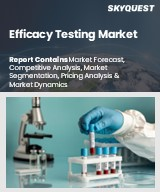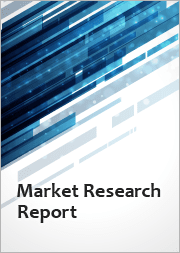
|
시장보고서
상품코드
1775647
유효성 시험 시장 규모, 점유율, 성장 분석 : 서비스 유형별, 용도별, 지역별 - 산업 예측(2025-2032년)Efficacy Testing Market Size, Share, and Growth Analysis, By Service Type, By Application, By Region - Industry Forecast 2025-2032 |
||||||
세계의 유효성 시험 시장 규모는 2023년에 3억 2,020만 달러로 평가되며, 2024년 3억 4,005만 달러에서 2032년에는 5억 5,023만 달러로 성장하며, 예측 기간(2025-2032년)의 CAGR은 6.2%로 성장할 전망입니다.
세계 유효성 시험 시장은 의약품 혁신의 수렴, 엄격한 규제 기준, 다양한 분야의 산업 수요 증가로 인해 강력한 성장세를 보이고 있습니다. 헬스케어 시스템이 고품질의 저렴한 의료 서비스를 제공하기 위해 노력하고 있는 가운데, 제약사들은 제품의 안전성과 임상적 유효성을 검증해야 한다는 압박에 직면해 있습니다. 제품 라벨링에 대한 소비자의 인식이 높아짐에 따라 규정 준수와 시장 수용성을 보장하기 위해 철저한 유효성 테스트가 필요하며, AI, 머신러닝, IoT, 증강현실, 가상현실과 같은 기술의 통합은 프로토콜을 최적화하고, 실시간 데이터 수집을 강화하며, 테스터의 몰입형 훈련을 촉진합니다. 몰입형 훈련을 촉진함으로써 유효성 시험에 혁명을 일으키고 있습니다. 또한 블록체인 기술을 활용하여 시험 과정의 무결성을 보장하고, 규제 당국의 기대와 소비자의 신뢰에 부응하는 투명성과 신뢰성을 확보할 수 있습니다.
목차
서론
- 조사의 목적
- 조사 범위
- 정의
조사 방법
- 정보 조달
- 2차와 1차 데이터 방법
- 시장 규모 예측
- 시장의 전제조건과 제한
개요
- 세계 시장 전망
- 공급과 수요 동향 분석
- 부문별 기회 분석
시장 역학과 전망
- 시장 개요
- 시장 규모
- 시장 역학
- 촉진요인과 기회
- 억제요인과 과제
- Porter의 산업 분석
주요 시장 인사이트
- 주요 성공 요인
- 경쟁의 정도
- 주요 투자 기회
- 시장 에코시스템
- 시장의 매력 지수(2024년)
- PESTEL 분석
- 거시경제 지표
- 밸류체인 분석
- 가격 분석
- 규제 분석
- 사례 연구
유효성 시험 시장 규모 : 서비스 유형별 & CAGR(2025-2032)
- 시장 개요
- 항균·방부제 유효성 시험
- 기존 시험 방법
- 신속한 검사 방법
- 소독제 유효성 시험
- 표면 시험 방법
- 현탁액 시험 방법
유효성 시험 시장 규모 : 용도별 & CAGR(2025-2032)
- 시장 개요
- 의약품 제조 용도
- 화장품 및 퍼스널케어 제품 용도
- 소비자용 제품 용도
- 의료기기 용도
유효성 시험 시장 규모 : 지역별 & CAGR(2025-2032)
- 북미
- 미국
- 캐나다
- 유럽
- 독일
- 스페인
- 프랑스
- 영국
- 이탈리아
- 기타 유럽 지역
- 아시아태평양
- 중국
- 인도
- 일본
- 한국
- 기타 아시아태평양
- 라틴아메리카
- 브라질
- 기타 라틴아메리카 지역
- 중동 및 아프리카
- GCC 국가
- 남아프리카공화국
- 기타 중동 및 아프리카
경쟁 정보
- 상위 5사의 비교
- 주요 기업의 시장 포지셔닝(2024년)
- 주요 시장 기업이 채택한 전략
- 최근 시장 동향
- 기업의 시장 점유율 분석(2024년)
- 주요 기업의 기업 개요
- 기업의 상세
- 제품 포트폴리오 분석
- 기업의 부문별 점유율 분석
- 매출의 전년대비 비교(2022-2024년)
주요 기업 개요
- Eurofins Scientific
- Charles River Laboratories
- Lucideon Limited
- Almac Group
- BluTest Laboratories, Ltd
- Bioscience Laboratories, LLC
- Abbott Analytical
- Pacific BioLabs
- Accugen Laboratories, Inc
- Intertek Group plc
- QIAGEN
결론과 제안
KSA 25.07.30Global Efficacy Testing Market size was valued at USD 320.2 million in 2023 and is poised to grow from USD 340.05 million in 2024 to USD 550.23 million by 2032, growing at a CAGR of 6.2% during the forecast period (2025-2032).
The global efficacy testing market is experiencing robust growth driven by a convergence of pharmaceutical innovations, stringent regulatory standards, and rising industrial demand across various sectors. As healthcare systems aim to deliver high-quality, affordable care, pharmaceutical companies face increasing pressure to validate the safety and clinical effectiveness of their products. Heightened consumer awareness about product claims necessitates thorough efficacy testing to ensure compliance and market acceptance. The integration of technologies such as AI, machine learning, IoT, augmented reality, and virtual reality is revolutionizing efficacy testing by optimizing protocols, enhancing real-time data collection, and facilitating immersive training for testers. Additionally, blockchain technology is being utilized to secure the integrity of testing processes, ensuring transparency and reliability that meet regulatory expectations and consumer trust.
Top-down and bottom-up approaches were used to estimate and validate the size of the Global Efficacy Testing market and to estimate the size of various other dependent submarkets. The research methodology used to estimate the market size includes the following details: The key players in the market were identified through secondary research, and their market shares in the respective regions were determined through primary and secondary research. This entire procedure includes the study of the annual and financial reports of the top market players and extensive interviews for key insights from industry leaders such as CEOs, VPs, directors, and marketing executives. All percentage shares split, and breakdowns were determined using secondary sources and verified through Primary sources. All possible parameters that affect the markets covered in this research study have been accounted for, viewed in extensive detail, verified through primary research, and analyzed to get the final quantitative and qualitative data.
Global Efficacy Testing Market Segments Analysis
Global Efficacy Testing Market is segmented by Service Type, Application and region. Based on Service Type, the market is segmented into Antimicrobial/ Preservative Efficacy Testing and Disinfectant Efficacy Testing. Based on Application, the market is segmented into Pharmaceutical Manufacturing Applications, Cosmetic and Personal Care Product Applications, Consumer Product Applications and Medical Device Applications. Based on region, the market is segmented into North America, Europe, Asia Pacific, Latin America and Middle East & Africa.
Driver of the Global Efficacy Testing Market
The Global Efficacy Testing market is primarily driven by the increasing implementation of stringent compliance standards by governments and regulatory authorities aimed at ensuring the safety, reliability, and effectiveness of pharmaceuticals, cosmetics, and medical devices. These regulations mandate the collection of extensive efficacy data prior to granting product approval for public use. Furthermore, ongoing post-market surveillance requirements necessitate continuous testing and validation, which fosters a sustained demand for efficacy testing services. This environment not only emphasizes the importance of rigorous efficacy evaluation but also ensures that companies remain accountable for their products' performance and safety throughout their lifecycle.
Restraints in the Global Efficacy Testing Market
The Global Efficacy Testing market faces several constraints due to its multifaceted nature, which includes various stages such as pre-clinical assessments, in-vitro and in-vivo trials, along with extensive field testing. These processes demand costly materials, advanced equipment, specialized personnel, and substantial operational expenditures. Furthermore, adhering to regulatory standards is a complex challenge, as it requires thorough laboratory evaluations and compliance with intricate, often evolving international testing protocols. As a result, these factors collectively hinder the growth and accessibility of efficacy testing, presenting significant barriers for companies within this sector.
Market Trends of the Global Efficacy Testing Market
The Global Efficacy Testing market is experiencing significant growth, fueled by the rising consumer demand for clean label and natural products. As health-conscious consumers increasingly prefer organic and preservative-free options, there is a greater need for comprehensive efficacy testing to ensure shelf stability and microbial resistance. This shift is prompting brands to collaborate with advanced laboratories to substantiate their marketing claims with robust data, including labels like "clinically proven" and "dermatologically tested." This trend not only enhances product credibility but also reflects a broader industry commitment to transparency and consumer safety, positioning efficacy testing as a crucial component in product development and marketing strategies.
Table of Contents
Introduction
- Objectives of the Study
- Scope of the Report
- Definitions
Research Methodology
- Information Procurement
- Secondary & Primary Data Methods
- Market Size Estimation
- Market Assumptions & Limitations
Executive Summary
- Global Market Outlook
- Supply & Demand Trend Analysis
- Segmental Opportunity Analysis
Market Dynamics & Outlook
- Market Overview
- Market Size
- Market Dynamics
- Drivers & Opportunities
- Restraints & Challenges
- Porters Analysis
- Competitive rivalry
- Threat of substitute
- Bargaining power of buyers
- Threat of new entrants
- Bargaining power of suppliers
Key Market Insights
- Key Success Factors
- Degree of Competition
- Top Investment Pockets
- Market Ecosystem
- Market Attractiveness Index, 2024
- PESTEL Analysis
- Macro-Economic Indicators
- Value Chain Analysis
- Pricing Analysis
- Regulatory Analysis
- Case Studies
Global Efficacy Testing Market Size by Service Type & CAGR (2025-2032)
- Market Overview
- Antimicrobial/ Preservative Efficacy Testing
- Traditional Testing Methods
- Rapid Test Methods
- Disinfectant Efficacy Testing
- Surface Test Methods
- Suspension Test Methods
Global Efficacy Testing Market Size by Application & CAGR (2025-2032)
- Market Overview
- Pharmaceutical Manufacturing Applications
- Cosmetic and Personal Care Product Applications
- Consumer Product Applications
- Medical Device Applications
Global Efficacy Testing Market Size & CAGR (2025-2032)
- North America (Service Type, Application)
- US
- Canada
- Europe (Service Type, Application)
- Germany
- Spain
- France
- UK
- Italy
- Rest of Europe
- Asia Pacific (Service Type, Application)
- China
- India
- Japan
- South Korea
- Rest of Asia-Pacific
- Latin America (Service Type, Application)
- Brazil
- Rest of Latin America
- Middle East & Africa (Service Type, Application)
- GCC Countries
- South Africa
- Rest of Middle East & Africa
Competitive Intelligence
- Top 5 Player Comparison
- Market Positioning of Key Players, 2024
- Strategies Adopted by Key Market Players
- Recent Developments in the Market
- Company Market Share Analysis, 2024
- Company Profiles of All Key Players
- Company Details
- Product Portfolio Analysis
- Company's Segmental Share Analysis
- Revenue Y-O-Y Comparison (2022-2024)
Key Company Profiles
- Eurofins Scientific
- Company Overview
- Business Segment Overview
- Financial Updates
- Key Developments
- Charles River Laboratories
- Company Overview
- Business Segment Overview
- Financial Updates
- Key Developments
- Lucideon Limited
- Company Overview
- Business Segment Overview
- Financial Updates
- Key Developments
- Almac Group
- Company Overview
- Business Segment Overview
- Financial Updates
- Key Developments
- BluTest Laboratories, Ltd
- Company Overview
- Business Segment Overview
- Financial Updates
- Key Developments
- Bioscience Laboratories, LLC
- Company Overview
- Business Segment Overview
- Financial Updates
- Key Developments
- Abbott Analytical
- Company Overview
- Business Segment Overview
- Financial Updates
- Key Developments
- Pacific BioLabs
- Company Overview
- Business Segment Overview
- Financial Updates
- Key Developments
- Accugen Laboratories, Inc
- Company Overview
- Business Segment Overview
- Financial Updates
- Key Developments
- Intertek Group plc
- Company Overview
- Business Segment Overview
- Financial Updates
- Key Developments
- QIAGEN
- Company Overview
- Business Segment Overview
- Financial Updates
- Key Developments
















